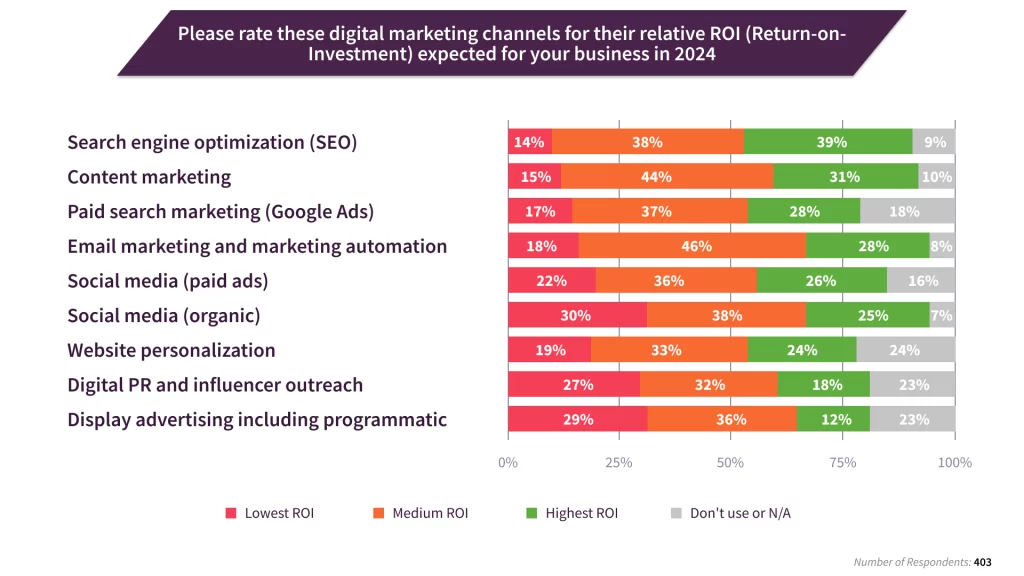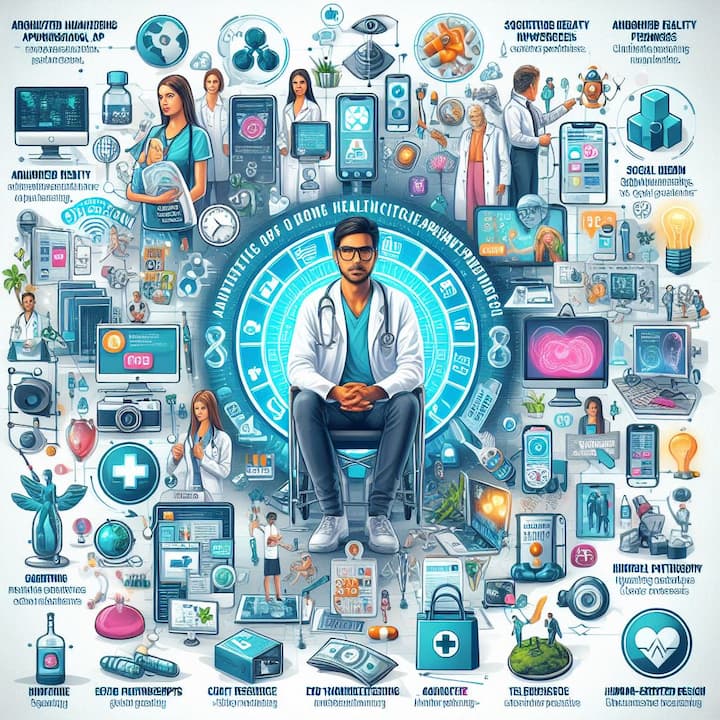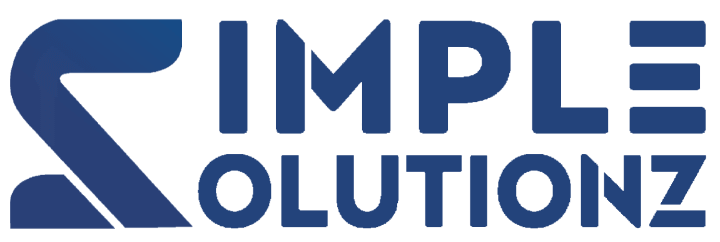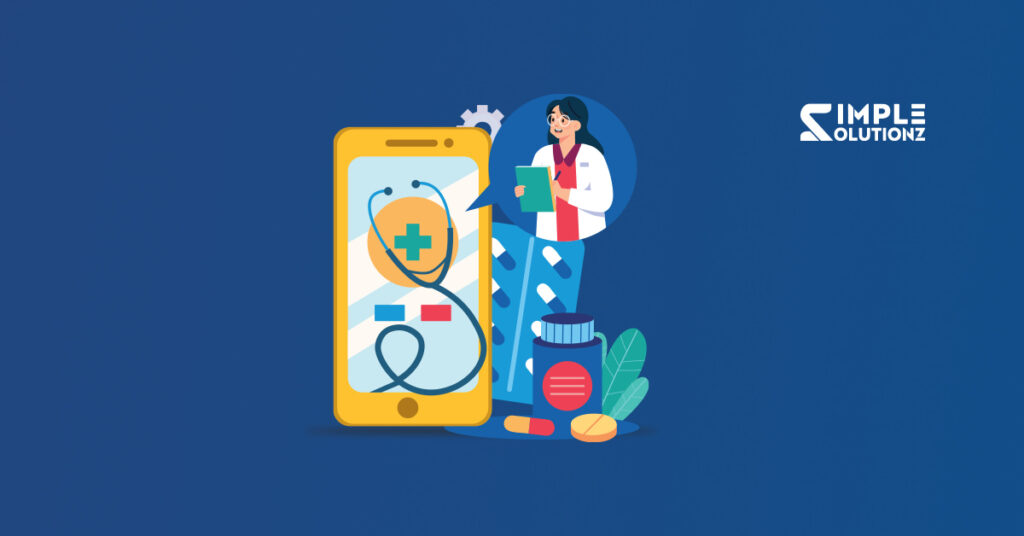There is no need to highlight the technological advancement in the healthcare industry. So, how can you attach yourself to leading marketing trends in 2024? Embracing the newest healthcare marketing trends will upgrade your marketing tactics to provide more impactful and relevant solutions to patients and healthcare providers.
We have sketched the top nine healthcare marketing trends for 2024. Learn them and implement them into your current marketing strategies.
Contents
- Introduction to Healthcare Marketing Trends
- 9 Digital Marketing Trends of 2024 in Healthcare
- 1. The Proliferation of Healthcare Apps
- 2. Telemedicine’s Revolutionary Role
- 3. AI and Personalized Healthcare Marketing
- 4. Personalized Content Creation
- 5. Data-Driven Marketing for Healthcare
- 6. Creating Patient Communities
- 7. Innovative Advertising Approaches in Healthcare
- 8. Social Media Campaigns for Community Engagement
- Social Media Platforms as Healthcare Marketing Trends
- 9. Influencer Marketing in Healthcare
- 1. Building Trust Through Expert Endorsement
- 2. Humanizing Medical Practices
- 3. Amplifying Health Education
- 4. Targeted Health Promotion
- 5. Navigating Patient Experiences
- 6. Increasing Brand Visibility and Awareness
- 7. Navigating Sensitive Health Topics
- 8. Compliance with Regulatory Standards
- 9. Measuring Impact and ROI
- 9. Influencer Marketing in Healthcare
- FAQ’s
Introduction to Healthcare Marketing Trends
Healthcare marketing is no longer confined to traditional methods. Embracing a diverse strategy to resonate with the modern consumer, it has expanded into the digital era. From leveraging the power of social media to crafting compelling content, healthcare marketers are exploring avenues that inform and foster meaningful connections.
Healthcare providers must prioritize personalized patient experiences and elevate their approach to patient engagement.
9 Digital Marketing Trends of 2024 in Healthcare
Digital marketing in healthcare extends far beyond a mere online presence. It encompasses a comprehensive approach, integrating various digital channels to create a seamless, personalized patient experience. From optimizing websites for user-friendly navigation to employing effective search engine optimization (SEO) strategies, healthcare organizations are investing in their digital infrastructure to enhance visibility and accessibility.

1. The Proliferation of Healthcare Apps
Healthcare apps have become indispensable tools, offering many services at users’ fingertips. From tracking vital signs to supplying medication reminders, these apps motivate individuals to take charge of their health. The rising prevalence of wearables and mobile devices has fueled the widespread adoption of healthcare apps, transforming how patients interact with their well-being.
2. Telemedicine’s Revolutionary Role
Telemedicine, a cornerstone of modern healthcare, has emerged as a revolutionary force in bridging the gap between patients and healthcare providers. The ability to conduct virtual consultations and remote monitoring has enhanced patient convenience. Still, it has expanded access to medical expertise, particularly for remote or underserved areas.
· Impact on Patient Engagement
The integration of mobile app solutions and telemedicine has redefined patient engagement strategies. Patients now have the means to participate actively in their healthcare journey. Through real-time monitoring and data-sharing capabilities, healthcare apps foster a continuous dialogue between patients and providers, promoting a proactive approach to health management.
· Enhancing Accessibility to Healthcare Services
One of the most notable impacts of healthcare apps and telemedicine is the democratization of healthcare access. Geographical barriers are diminished as individuals get guidance from healthcare professionals from their homes. It is particularly advantageous for those with mobility constraints, chronic conditions, or limited access to local healthcare facilities.
· Improved Chronic Disease Management
Healthcare apps play a pivotal role in chronic disease management. Patients with diabetes or hypertension can utilize apps to monitor their health metrics, receive timely reminders for medication, and share data with their healthcare providers. This proactive management approach improves health outcomes and reduces the burden on traditional healthcare systems.
3. AI and Personalized Healthcare Marketing
Artificial Intelligence is helping in a new era in healthcare marketing, redefining how organizations engage with patients on a personalized level. The integration of AI technologies empowers healthcare providers to tailor their marketing strategies, delivering content and services that are not only relevant but resonate with the unique needs of individual patients. Let’s delve into the multifaceted role of AI in shaping personalized healthcare marketing.
· Predictive Analytics for Targeted Outreach
AI-driven predictive analytics revolutionize how healthcare marketers identify and reach their target audience. By analyzing vast datasets, AI algorithms can predict patient behaviors, preferences, and healthcare needs. This predictive capability enables healthcare organizations to proactively engage with individuals more likely to benefit from specific services, treatments, or preventive measures.
4. Personalized Content Creation
AI is pivotal in crafting personalized content that speaks directly to individual patients. Natural Language Processing (NLP) algorithms analyze patient data, including medical history, preferences, and demographics, to generate tailored content. Whether email campaigns, educational materials, or social media content, AI ensures the messaging is accurate and resonates with each patient’s unique characteristics.
· Customized Patient Communication
AI-driven chatbots and virtual assistants enable real-time, personalized communication with patients. These intelligent systems can answer queries, provide information, and even schedule appointments based on individual preferences and healthcare needs. The result is a more responsive, patient-centric communication approach fostering engagement and trust.
· Precision Targeting in Advertising
AI enhances the precision of targeted advertising in healthcare. AI algorithms can recognize the most effective channels and messaging for specific demographic groups by analyzing patient data. This targeted approach minimizes wasted resources and ensures that marketing efforts enable individuals to respond positively.
5. Data-Driven Marketing for Healthcare
Data analytics has become a meaningful change in shaping more effective and targeted healthcare marketing trends. Data-driven marketing leverages insights from vast datasets to inform decision-making, personalize patient interactions, and optimize overall marketing efforts.
Let’s discuss the multifaceted role of data analytics in healthcare marketing.
· Personalization of Patient Communications
One of the main advantages of data-driven marketing is its ability to personalize patient communications. Analyzing patient data allows healthcare providers to understand individual preferences, health history, and engagement patterns. This information can be leveraged to craft personalized emails, newsletters, and other communication materials that resonate with each patient personally, fostering a stronger connection and engagement.
· Predictive Analytics for Proactive Outreach
Predictive analytics, a subset of data analytics, empowers healthcare marketers to be proactive in their outreach efforts. Arms can predict future patient behaviors, health trends, and potential healthcare needs by analyzing historical data. This foresight allows healthcare organizations to reach out to patients with timely and relevant information, preventive care suggestions, or appointment reminders, contributing to a more proactive and preventative approach to healthcare.
· Campaign Optimization and ROI Measurement
Data-driven marketing provides the tools to measure the effectiveness of marketing campaigns with precision. Through key performance indicators (KPIs) and analytics tools, healthcare marketers can assess the impact of various strategies and optimize campaigns in real-time. This iterative process allows for continuous improvement, ensuring marketing resources are allocated to initiatives that deliver the highest return on investment (ROI).
· Improving Patient Experience
Understanding patient experiences is paramount for healthcare providers, and data analytics is crucial. By analyzing patient feedback, complaints, and satisfaction surveys, healthcare organizations determine areas for improvement and tailor their marketing strategies to enhance the overall patient experience. This patient-centric approach not only improves satisfaction but also contributes to brand loyalty.
6. Creating Patient Communities
Your patients actively explore online forums, conduct Google searches, and visit platforms like WebMD to gain insights into their conditions and connect with others facing similar experiences. They yearn for a community that understands their journey. By establishing online patient communities on your website, you can unite patients, offering the supportive community they seek. This fulfills their desire for understanding and strengthens your marketing initiatives.
7. Innovative Advertising Approaches in Healthcare
The healthcare industry is embracing innovative advertising approaches to connect with audiences more compellingly and meaningfully. These approaches go beyond traditional methods, incorporating creativity, technology, and a deep understanding of human emotions.

Let’s explore some of the innovative advertising methods healthcare organizations adopt, focusing on integrating storytelling and emotional appeal.
· Visual Storytelling Through Multimedia Campaigns
Healthcare organizations are increasingly leveraging the power of visual storytelling through multimedia campaigns. Videos, animations, and interactive content create a more immersive and engaging narrative. These campaigns go beyond conveying medical information; they tell stories of resilience, recovery, and human experience, making healthcare more relatable and emotionally resonant.
· Personalized Patient Journeys in Advertisements
Innovative healthcare ads now feature personalized patient journeys rather than highlighting generic scenarios. Organizations can humanize their brand by highlighting real patients’ stories, challenges, and triumphs. This approach builds empathy and creates a connection between the audience and the healthcare services, fostering a sense of trust and authenticity.
· Interactive and Immersive Experiences
Innovative healthcare advertising goes beyond passive viewing; it aims to create interactive and immersive experiences for the audience. Virtual reality (VR) and augmented reality (AR) are employed to simulate medical procedures, allowing patients to experience the process virtually. This not only educates but also reduces anxiety and fear associated with medical interventions.
8. Social Media Campaigns for Community Engagement
Social media has become a dynamic platform for healthcare organizations to connect with their audience. Innovative social media advertising on platforms like Instagram, Twitter, and Facebook involves creating shareable content, organizing interactive campaigns, and fostering community engagement. Transform your marketing campaign by actively participating in online conversations; healthcare providers can build a sense of community and increase visibility.
Facebook: Facebook serves as a versatile platform for healthcare community engagement. With its extensive user base, healthcare organizations can share informative content, host live sessions, and facilitate community discussions through groups. The platform’s targeted advertising options enable a precise audience to reach, making it a valuable tool for health awareness campaigns and patient outreach.
Twitter: Twitter’s real-time nature is ideal for healthcare organizations to share health tips updates and engage in timely conversations. Utilizing hashtags relevant to healthcare trends fosters visibility and participation. Twitter facilitates direct communication, making it an effective platform for addressing patient queries and disseminating concise health information.
Instagram: Instagram’s visual appeal is leveraged by healthcare marketers through impactful images and short videos. PPC (Pay Per Click) marketing can be used for educational content, behind-the-scenes glimpses, and patient testimonials. Instagram’s emphasis on aesthetics helps humanize healthcare, creating an emotional connection with the audience.
LinkedIn: LinkedIn caters to a professional audience, making it an ideal platform for B2B healthcare engagement. Healthcare organizations can share industry insights, thought leadership articles, and job opportunities. Building a strong professional network on LinkedIn enhances credibility and fosters collaboration within the healthcare community.
TikTok: TikTok’s popularity among younger demographics allows healthcare marketers to engage creatively with a diverse audience. Short, engaging videos can convey health messages, promote wellness challenges, and even highlight a lighter side of healthcare professionals, making the content relatable and shareable.
Social Media Platforms as Healthcare Marketing Trends
Patient Education: Platforms offer opportunities to share accurate health information, debunk myths, and educate patients on preventive care.
Influencer Partnerships: Collaborating with healthcare professionals or patient advocates on social media can amplify the reach of health campaigns and foster trust.
Live Engagement: Live sessions and Q&A forums provide real-time interaction, allowing healthcare providers to address concerns directly and establish a personal connection with the audience.
Community Building: Social media platforms enable the creation of healthcare communities where patients can share experiences, seek advice, and support one another.
Targeted Advertising: The robust advertising capabilities of platforms allow healthcare marketers to target specific demographics, ensuring that health campaigns reach the right audience effectively.
9. Influencer Marketing in Healthcare
In recent years, influencer marketing has transcended traditional industries, finding its place even in the nuanced world of healthcare. While once reserved for fashion, lifestyle, and beauty brands, influencer marketing in healthcare is gaining traction, reshaping how patients perceive medical services, treatments, and products.

Let’s delve into the nuances of influencer marketing in healthcare and how it influences the industry.
1. Building Trust Through Expert Endorsement
Healthcare influencers, often comprising doctors, nurses, or medical professionals, bring a unique blend of expertise and relatability. Their endorsements and recommendations carry significant weight, building trust among their audience. Patients are more likely to trust healthcare information from a credible influencer who understands the industry’s intricacies.
2. Humanizing Medical Practices
Healthcare influencers have the power to humanize medical practices. Sharing personal stories, experiences, and insights breaks down the perceived barriers between healthcare providers and patients. This human touch fosters a sense of connection and understanding, crucial elements in an industry often seen as clinical and intimidating.
3. Amplifying Health Education
Influencers in healthcare leverage their platforms to disseminate valuable health information. Whether explaining complex medical conditions, debunking myths, or offering practical wellness tips, healthcare influencers play a vital role in educating the public. Their ability to simplify medical jargon makes health information more accessible and digestible.
4. Targeted Health Promotion
Healthcare influencers cater to specific niches within the industry. From mental health advocates to fitness enthusiasts, these influencers allow for targeted health promotion. This specialization enables healthcare brands to reach their desired audience precisely, ensuring their message resonates with those who need it most.
Influencers often share their healthcare journeys, from diagnosis to treatment and recovery. These narratives provide a real-world perspective on healthcare experiences, helping potential patients navigate their journeys. This firsthand insight is invaluable, offering a glimpse into various healthcare processes’ emotional and practical aspects.
6. Increasing Brand Visibility and Awareness
Collaborating with healthcare influencers is an effective strategy for increasing brand visibility. These influencers have dedicated followers who trust their recommendations. A well-executed influencer marketing campaign can introduce healthcare brands to a broader audience, fostering brand awareness and recognition.
Some healthcare topics are inherently sensitive, and influencers can serve as a bridge to broach these subjects. By discussing mental health, chronic illnesses, or other stigmatized conditions, influencers contribute to reducing societal taboos and encourage open conversations about health.
8. Compliance with Regulatory Standards
Healthcare influencers need to comply with ethical and legal standards. Disclosures about their qualifications, potential conflicts of interest, and adherence to patient privacy regulations are crucial. This ensures that influencer marketing in healthcare maintains integrity and credibility.
9. Measuring Impact and ROI
As with any marketing strategy, measuring the impact of influencer marketing in healthcare is vital. Metrics such as engagement rates reach, and conversion rates are tracked to identify the effectiveness of campaigns. Understanding the return on investment (ROI) helps healthcare marketers refine their strategies for optimal results.
FAQ’s
What are the objectives of healthcare marketing?
- Increasing patient awareness of healthcare services.
- Building trust and credibility for healthcare providers and organizations.
- Encouraging patient engagement and education.
- Promoting preventive care and healthy lifestyles.
- Attracting and retaining patients.
- Differentiating healthcare brands in a competitive market.
- Enhancing overall patient satisfaction and experience
How to create a marketing strategy for healthcare?
- Define your target audience and understand their needs.
- Establish clear and measurable goals.
- Leverage digital marketing channels, including social media and content marketing.
- Implement search engine optimization (SEO) for online visibility.
- Utilize patient testimonials and success stories.
- Ensure compliance with healthcare regulations and patient privacy laws.
- Foster community engagement through local events and partnerships.
- Continuously analyze data and adjust strategies based on performance.
What will be the top 5 content marketing trends of 2024?
While the landscape may evolve, anticipated content marketing trends in 2024 include:
- Interactive Content
- Video Content Domination
- Personalized Content
- Voice Search Optimization
- Sustainability Focus
What is the next big marketing trend?
The next big marketing trend will be centered around Metaverse Marketing, leveraging virtual and augmented reality for immersive brand experiences. This emerging trend has the potential to reshape how brands engage with their audience in a virtual space.
What are the challenges of healthcare marketing?
- Navigating strict healthcare regulations.
- Safeguarding patient data and ensuring privacy.
- Establishing trust in a sector with sensitive information.
- Integrating technology without losing human touch.
- Communicating complex medical information effectively.
- Standing out in a crowded and competitive healthcare market.

